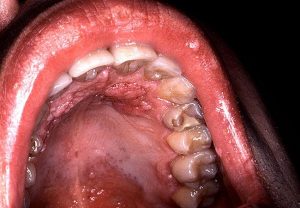Throat Cancer’s Link to Oral Sex: What You Should Know
Throat Cancer’s Link to Oral Sex: What You Should Know
Learn about symptoms, risks and prevention
You likely think of cervical cancer when you hear about the rising incidence of human papilloma virus (HPV). So you might be surprised to learn that this sexually-transmitted virus is also a leading cause of throat cancer (oropharyngeal cancer), and it spreads from person to person via oral sex.
Though oral cancers have long been linked to smoking, head and neck surgeon Brandon Prendes, MD, says current research shows that HPV is directly related to some throat cancers. In fact, these cancers are on the rise, and soon will outpace new cervical cancer cases, he says.
According to Centers for Disease Control and Prevention data, there are 9,000 new cases of throat cancer diagnosed annually that are potentially related to HPV. Approximately 7 percent of adults have oral HPV, but only about 1 percent have the particular type associated with throat cancer: HPV 16.
RELATED: Oral Human Papilloma Virus (HPV) Infection
What are the risks?
The No. 1 risk in contracting oral HPV and developing HPV-related throat cancer is having multiple oral sex partners, Dr. Prendes says. Having a higher number of partners increases the risk for both men and women.
Women experience less HPV-related throat cancer, researchers say, because they may have developed an immunological response to fight off cervical cancer. Men don’t have the same immunity.
Smoking also raises risk, Dr. Prendes says. You’re at greatest risk if you smoke at least a pack a day for 10 years.
RELATED: Newly Approved DNA Test for HPV Could Replace Your Pap
How do you limit your risks?
Here are five ways to help you limit your risk of HPV-related throat cancer, according to Dr. Prendes.
Limit number of lifetime sexual partners.
The increase in risk involved with greater numbers of sexual partners is even greater for oral sexual partners. Also, use condoms or dental dams consistently for some protection.
Get children and young adults vaccinated.
For males and females between ages 9 and 26, a three-round HPV vaccinecan ward off HPV infection.
Get screened.
Regular screening increases the chances you’ll catch a tumor early. Your doctor will feel your neck, examine your throat and inspect your mouth.
Visit your dentist.
Get regular dental checkups because dentists are often the first practitioners to notice abnormalities with the tongue and tonsils.
Limit smoking and alcohol.
Quit smoking and reduce alcohol consumption to cut your risk.
RELATED: HPV Vaccines: Safe, Protective for Kids
What symptoms should you watch for?
HPV-related throat cancer symptoms can often go largely overlooked, Dr. Prendes says, because they’re difficult to recognize and categorize. If any of the symptoms lasts beyond two weeks, see your doctor or an ear, nose and throat specialist. The symptoms include:
- Neck mass or swelling
- Ear pain
- Painful swallowing (like something is stuck in the back of your throat)
- Snoring (as a new issue, without sudden weight gain)
- Difficulty eating
- Vocal changes (hoarseness)
- Sore throat
- Enlarged lymph nodes
- Unexplained weight loss
HPV oral cancers slow to develop, but quick to spread
HPV-related cancers spread quickly to the lymph nodes. It’s not that the tumors spread quickly due to issues with the immune system — they spread quickly for unknown reasons. However, they show up first as large swollen lymph nodes because the body has an immune response at the site of the lymph nodes once tumor reaches this area, causing swelling and a noticeable neck mass, Dr. Prendes says. So, these cancers are often diagnosed in advanced stages.
It can take up to 30 years for HPV-related throat cancer to appear, making it most common in adults between the ages of 40 and 60. The Oral Cancer Foundation reports it’s growing fastest among men, ages 25 to 55.
Dr. Prendes says researchers have developed a clinical test that searches for the P16 molecular marker in biopsy samples, a marker that indicates HPV-related cancer. Successful treatment and cure rates are high if you know what to look for and know your risk, he says.
Overall, HPV-related throat cancers respond well to surgery and radiation. Between 90 and 95 percent of diagnosed cases have five-year, disease-free survivorship rates, he says.
Although researchers are still learning more about HPV-related throat cancer, the verdict about whether HPV is truly to blame is in, Dr. Prendes says.
“I don’t think anyone in our field or any epidemiologist would argue the link between HPV and throat cancer at this point,” he says. “It’s a strong link.”
April 13, 2016 / By Cancer Care Team
Further information on HPV (Genital Wart) is available below


